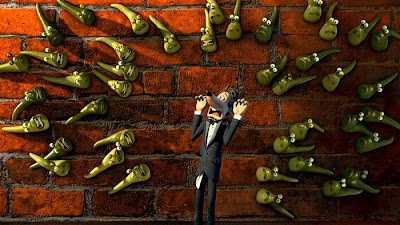
G.K.: Garrison Keillor
Yolanda Johnson: Meryl Streep
Guy Noir: Kevin Klein
Lola Johnson: Lindsay Lohan
Rhoda Johnson: Lily Tomlin
Dusty: Woody Harrelson
Lefty: John C. Reilly
Molly: Maya Rudolph
Dangerous Woman: Virginia Madsen
Axeman: Tommy Lee Jones
Picturehouse presents a film directed by Robert Altman. Written by Garrison Keillor and Ken LaBeznik, based on the radio program hosted by Garrison Keillor. Running time: 105 min. Rated PG-13 (for risqué humor).
“It was the Mid West, where they think if they ignore bad news, it will just go away.”
Guy Noir speaks these words in “A Prairie Home Companion”, the final film of director Robert Altman, one of the greatest and most influential filmmakers ever to mold cinema into an art form. The quote is an observational joke that, like most of Altman’s work, captures a subtle truism of human nature existing on a level many are aware of but never articulate.
Altman made plenty of controversial films, with large casts and a distinctive style of overlapping dialogue and storylines. “A Prairie Home Companion” differs only in that it is devoid of controversy. This is a warm, loving film of songs and humor that in retrospect will seem like a fond farewell from a director who excelled at observing the human spirit and celebrated it with his unique vision.
“A Prairie Home Companion” is based on the nationally syndicated National Public Radio show of the same name that broadcasts each week from Minnesota. Hosted by Garrison Keillor, the long-running radio show tells the bemused tales of the fictional town of Lake Wobegon and runs like an old fashioned radio review, focusing on the characters who live in and drift through the town with anecdotes and songs. Keillor co-wrote the screenplay and stars as himself in the film.
The film is a fictionalized account of the radio program’s final show. (In reality, it is still going strong and probably will for as long as Keillor is around to produce it). As those words spoken by Guy Noir near the beginning of the picture suggest, the cast of the radio program do their best to approach this final show as if it were any other. This lends a simplicity to the events which contrasts with most of Altman’s convoluted character weavings.
The large cast includes an eclectic mix of Hollywood talent. Kevin Kline (“The Pink Panther”) plays Noir as gumshoe narrator and the show’s head of security. Lily Tomlin (“I Heart Huckabees”) and Meryl Streep (“The Devil Wears Prada”) play singing sisters reflecting upon their life long careers, and Lindsay Lohan (“Mean Girls”) is Streep’s bookish daughter, who gets a chance to debut her singing talents in the show’s final moments. Woody Harrelson (“North Country”) and John C. Reilly (“Talladega Nights”) are a couple of very funny crooning cowboys. And Saturday Night Live’s Maya Rudolph is the show’s put-upon pregnant stage manager.
Altman injects some of his dark twang into the proceedings when one of the cast members (the great western character actor L.Q. Jones) passes away in his dressing room after his final performance. The character of the Dangerous Woman (Virginia Madsen, “Sideways”) plays into this storyline and proves more necessary than she is dangerous. She also helps bring closure to how the cast feels about The Axeman (Tommy Lee Jones, “Men in Black”), who represents the theater’s parent company responsible for pulling the plug on the show.
Despite these more direct references to death, the film is a pleasant requiem for this family of professional performers. It’s an intimate look at the performances and the backstage choreography involved in creating this unique show. There are some wonderful musical moments that can just be appreciated for what they are, and the rest really serves those performances more than anything else.
While I doubt Altman planned for “A Prairie Home Companion” to be his swan song, he could not have chosen a more fitting project. Yes, people in the Mid West really do deal with bad news by ignoring it and hoping it will vanish, and the death of Altman last week at the age of 81 is bad news that undoubtedly will not go away, no matter how much we may wish otherwise. Like the best stories from Lake Wobegon, however, his films, will undoubtedly be with us for untold years to come; Altman, after all, was one of the greatest filmmakers to ever bless the screen with his vision.




